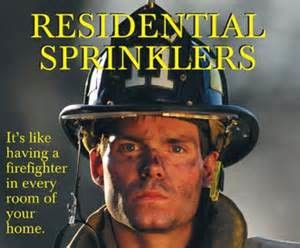By: Robert Avsec, Executive Fire Officer
Last week, I wrote a piece on a tragic home fire in Chesterfield County, Virginia, USA where five people lost their  lives (while five others were able to escape the flames). My theme in the article was that we–the fire service in particular–have to become more active in advocating, and yes demanding, that residential fire sprinklers be a requirement for all new residential housing regardless of its size.
lives (while five others were able to escape the flames). My theme in the article was that we–the fire service in particular–have to become more active in advocating, and yes demanding, that residential fire sprinklers be a requirement for all new residential housing regardless of its size.
The following is a comment to that article that was posted on one of the LinkedIn Groups that I shared the article with and comes from Michael Dube, a Certified Organizational Resilience Specialist (CORS), in Ontario, Canada:
On January 18, 2016, there was a fire locally (Collingwood, Ontario) in an 80-year old farmhouse. Thirteen people (4 adults and 9 children under 16 years of age) were asleep. All thirteen people escaped the fire, since they responded correctly when the smoke alarms sounded. Arriving firefighters found the house fully engulfed in flames; no injuries to occupants. The fire prevention and education programs enforced by the fire service are what saved these people – knowledge instead of technology. Since legislators seem to be reluctant to develop a law mandating fire sprinklers, perhaps a more aggressive approach to educating and training everyone – developing resilience – would work better, faster. We cannot win them all, even with the best technology, as long as human unpredictability is a factor. Situational awareness for citizens has a greater chance of saving lives.
Another of my LinkedIn Connections, Samantha Hoffmann, Fire and Life Safety Officer with the Barrie (ON) Fire and Emergency Services Department, posted this comment:
Great story Mike. That’s one we need to get the media reporting on. We need to focus on why people are not dying in fires instead of those that are. What steps are they taking to survive?
Here’s my take:
I could not agree more with Michael’s comments and insights (Yes, I can be a “knowledge guy” and a “technology guy” in equal measures!) I agree with Samantha as well (I’m a pretty agreeable guy) that we need greater media coverage of the success stories…Oh, wait, we don’t NEED the media to do our job.
 We have more access to more communication channels than ever in the history of the human race: social media platforms which is now being enhanced by combining this great service along with it. We have to get better at capturing the success story when it happens with our own “on-scene” interviews with fire survivors telling their story in real time. When the fear and thankfulness are still in their eyes and their voices. And when they are the ones saying:
We have more access to more communication channels than ever in the history of the human race: social media platforms which is now being enhanced by combining this great service along with it. We have to get better at capturing the success story when it happens with our own “on-scene” interviews with fire survivors telling their story in real time. When the fear and thankfulness are still in their eyes and their voices. And when they are the ones saying:
- “When I heard the smoke alarm going off…”
- “Honey (Mom looking at her child), you were so brave! You got you and your sister out of the house just like we practiced.” [They had a Home Fire Escape Plan and had practiced it]
- “When we couldn’t get down the hallway to the boys’ bedroom [on second floor] we hoped and prayed they remembered how to get out. Our hearts burst with relief and joy when we saw the escape ladder hanging from the window and our two boys standing by the big oak tree.”
Those messages would be much more powerful than the same story told days, weeks, or even months later with Mom, Dad, and their four children sitting in the [Insert any sterile location that has no connection to the fire, e.g., TV studio or relative’s living room].
And delivering that message via social media, e.g., Instagram, Facebook, Twitter, etc., would be getting that story to more people via  their primary means of getting information today: their smartphones and tablets, not the 6:00 pm local news broadcast. (Did you know that industry experts state that around 65% of people today get their on-line content via their wireless devices, e.g., smartphones and tablets, like the best digital drawing tablet, as opposed to desktop computers?)
their primary means of getting information today: their smartphones and tablets, not the 6:00 pm local news broadcast. (Did you know that industry experts state that around 65% of people today get their on-line content via their wireless devices, e.g., smartphones and tablets, like the best digital drawing tablet, as opposed to desktop computers?)
Radical idea? Consider this: people don’t wear their seatbelts nor do they drink and drive because we told them “warm & fuzzy” stories of why they should adopt those behaviors, do they? No, people buckle up in their cars and they don’t drink and drive because of news coverage and public safety announcements (PSAs) that emphasized the terrible outcomes–with powerful graphics and images and words–that drove home the message. Like today’s campaigns to stop drivers from texting while driving.
 Fire & EMS Leader Pro The job of old firefighters is to teach young firefighters how to become old firefighters!
Fire & EMS Leader Pro The job of old firefighters is to teach young firefighters how to become old firefighters!